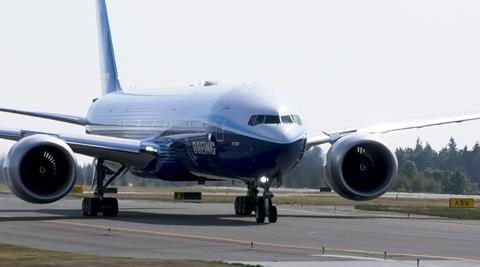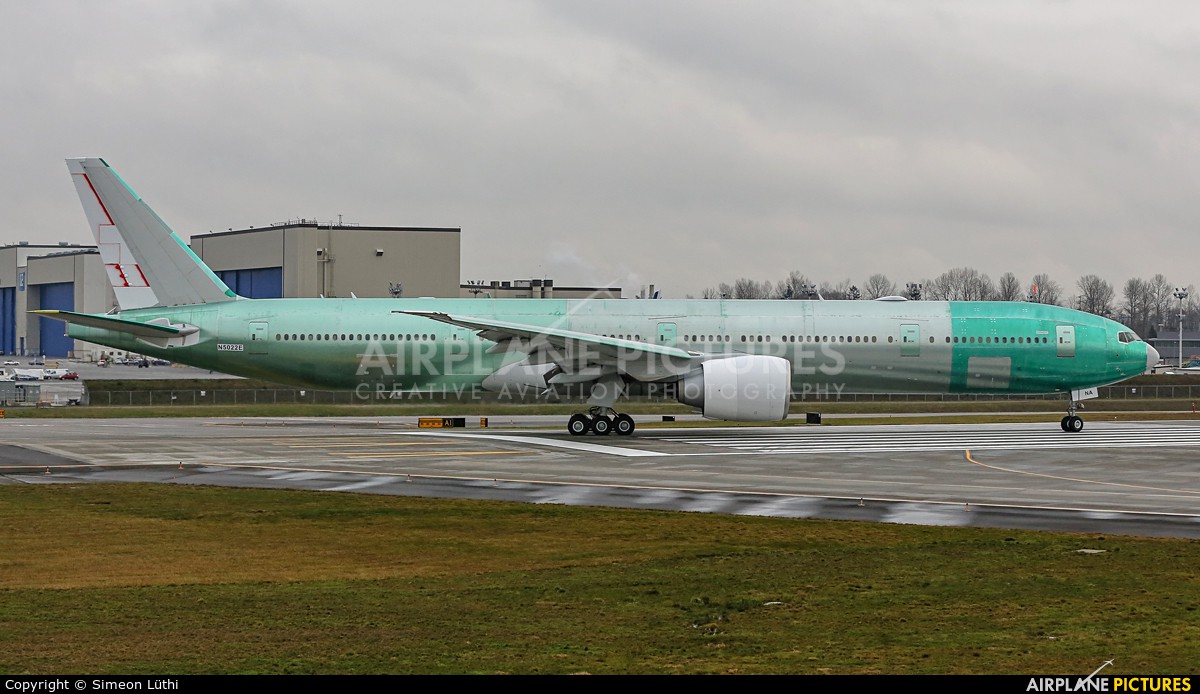The Boeing 777 wide-body is the world’s largest twin-engine jet airliner, first flown in June of 1994. Commonly referred to as the ‘Triple Seven,’ the 777 is Boeing’s first fly-by-wire airliner (an electronic system that replaces the conventional manual flight controls of an aircraft) and the first commercial aircraft entirely computer-designed. The aircraft is used on long-range flights where the capacity of the much larger 747 is not required. Up to 451 people can be carried in some versions of the aircraft, making it an attractive fuel-efficient option since it can fly on only two engines.
One year ago to the day, on January 25th, 2020, Boeing’s much-anticipated flagship aircraft, the 777X, took its first flight. The new widebody took off from Paine Field in Everett, Washington, powered by a pair of purpose-built GE9X engines at 10:09 local time. The new Boeing 777X jetliner completed its first flight on 25 January. The aircraft is based on the manufacturer’s 777 and features technologies from Boeing’s 787 Dreamliner. The 777X took to the skies at Paine Field in Everett, Washington and landed at Seattle’s Boeing Field. The Boeing Company's 777 jetliner landed after a first flight of nearly four hours that began an ambitious testing program for the manufacturer's latest all-new model in this century. Twenty-five years prior, however, the first Boeing 777 airliner made its first flight in June 1994— kicking off a career that would revolutionize the airline industry. In the two decades since its.
Boeing 777 Facts
- The Boeing 777 is the world’s largest twinjet.
- The first Boeing 777 model, the 777-200, entered commercial service with United Airlines in 1995.
- Ranks as one of Boeing’s best-selling models.
- Typical seating capacity of between 314 and 451 passengers.
- Flight range between 5,235 and 8,555 nautical miles.
- Direct competitors: Airbus A330-300, Airbus A350 XWB, Airbus A340 (out of production), and McDonnell Douglas MD-11 (out of production).
- Asiana Airlines Flight 214 crash represented the first fatal Boeing 777 crash in roughly 18 years of service.
- Boeing now working on the 777-8X and 777-9X, new variants with improved engines and other technologies. Should be available in 2020.
Boeing 777 Aircraft Variants
There are several different variants of the Boeing 777. The company defines their 777 models based on fuselage length (which determines how many passengers can fit within the plane) and range (how far the plane can fly between takeoff and landing, as allowed by fuel capacity).
Range is categorized by three different market segments:
- A Market – Up to 4,200 nautical miles
- B Market – Up to 6,600 nautical miles
- C Market – Up to 7,800 nautical miles
Boeing 777-200 – The first Boeing 777-200 was delivered to United Airlines in 1995 as the initial A Market 777. The 777-200 has a maximum range of 5,240 nautical miles (9,700 km) and was aimed at U.S. domestic airline operators.
At present, there are nine different airlines with Boeing 777-200 planes in their fleet. The closest competitor to the 777-200 is the Airbus A330-300.
Boeing 777-200ER – The major difference between the Boeing 777-200 and the 777-200ER (ER stands for ‘extended range’) is that the 777-200ER has a longer range with a higher maximum takeoff weight. As the first B Market 777, the Boeing 777-200ER was aimed at international airlines that operate transatlantic routes.

The first airline to add the Boeing 777-200ER to its fleet was British Airways in 1997. Singapore Airlines is one of the largest Boeing 777-200ER customers.
Live Stream Boeing 777 First Flight
Boeing 777-200LR – The LR stands for ‘long-range’ and was specifically developed for ultra-long-haul routes, one of which being the Los Angeles to Singapore route. Developed alongside the 777-300ER, the 777-200LR belongs to the C Market. It has been nicknamed the ‘Worldliner’ because, in theory, it can connect any two airports in the world. The Boeing 777-200LR holds the record for the longest nonstop flight by any commercial airliner.
Boeing 777-300 – The Boeing 777-300 was designed to be a replacement option for the Boeing 747-100 and 747-200. The Boeing 777-300 shares a similar passenger capacity to the 747-100’s and 747-200’s, but consumes about a third the amount of fuel and is estimated to cost 40 percent less to maintain. As an A Market aircraft, the Boeing 777-300 is most widely used by Asian airlines flying heavily-traveled Japanese routes.
Boeing 777-300ER – The Boeing 777-300ER (extended range) features raked and extended wingtips, a larger wing aspect ratio (9.0), reinforced nose gear, new main landing gear, and additional fuel tanks. The aircraft was also built with a strengthened engine attachment, fuselage, empennage, and wings. The 777-300ER features GE90-115B turbofan engine, the most powerful jet engine currently in use. As a C Market aircraft, the Boeing 777-300ER can fly roughly 30 percent further than the 777-300, even when loaded with passengers and cargo.
The Boeing 777-300ER is the highest-selling Boeing 777 variant.
Boeing 777F – The Boeing 777F (the F is for Freightliner) has the same features as the 777-200ER, only geared toward hauling cargo instead of passengers. The aircraft’s cargo capacity is similar to that of the Boeing 747-200F. The cargo plane has a maximum range of 4,900 nautical miles (at maximum payload).
Boeing 777-8X and 777-9X – The Boeing 777-X family of aircraft are currently under development. The 777X series will have new engines, composite wings, and technology similar to that of the Boeing 787. The 777-8X and the larger 777-9X are intended to compete with the Airbus A350. Sources have indicated that the 777-9X will be service ready in 2020.
Boeing 777VIP – The Boeing 777VIP (777 Business Jet) was designed for corporate customers. The company has received orders for the 777VIP to be constructed similar to the 777-200LR and 777-300ER. The main difference: the 777VIP will feature private passenger cabins. Boeing 777VIP’s serve as official government transports for the nations of Gabon (VIP-configured 777-200ER), Turkmenistan (VIP-configured 777-200LR), and the United Arab Emirates (VIP-configured 777-200ER and 777-300ER operated by Abu Dhabi Amiri Flight).
Boeing KC-777 – A tanker version of the 777, the Boeing KC-777 (777 Tanker) was proposed in September 2006. Boeing announced that the KC-777 would be produced for the U.S. Air Force if it required a larger tanker aircraft than the KC-767. Boeing officials have indicated the KC-777 would be a suitable replacement for the wide-body McDonnell Douglas KC-10 Extender.
Largest Boeing 777 Operators
As of July of 2015, Emirates is the airline with the largest fleet of Boeing 777 aircraft. Emirates is also the only airline in the world that has operated all 777 variants (777-200, 777-200ER, 777-200LR, 777-300, 777-300ER, and 777F). The International Lease Finance Corporation (ILFC), Singapore Airlines, United Airlines, and Air France are the other largest consumers of Boeing 777 aircraft.
Boeing 777 Incidents and Accidents

777 First Flight 1994
The 777 has an enviable safety record since its introduction in 1995, though the aircraft has been involved in a number of serious incidents and accidents. Below are several of the most serious Boeing 777 incidents and accidents:
777-9x First Flight

First Flight Of Boeing 777x
- January 6, 2018 – Two Boeing 777s clipped each other at John F. Kennedy Airport in New York. The accident happened when a China Southern aircraft was being towed and its right wing tip clipped the tail of a Kuwait Airways aircraft that was parked while awaiting take-off. No one onboard the Kuwait Airways plane was injured but the flight was canceled due to the Boeing 777 being deemed inoperable. There were no passengers or crew on the China Southern aircraft.
- September 8, 2015 – British Airways Flight 2276 caught fire on a runway at McCarran International Airport in Las Vegas. Initial reports indicate the General Electric GE90-85B engine suffered a serious engine failure. The flight was aborted and the passengers and crew members were evacuated using the emergency slides. Minor injuries were reported.
- July 17, 2014 – Malaysia Airlines Flight 17 was heading to Kuala Lumpur from Amsterdam when the Boeing 777-200ER was hit by an anti-aircraft missile. The plane went down in the Donetsk province in eastern Ukraine. All 283 passengers and 15 crew members on the plane were killed.
- March 8, 2014 – Boeing 777’s most recent hull loss was Malaysia Airlines Flight 370 that was reported missing en route from Kuala Lumpur to Beijing. The Boeing 777-200ER was carrying 227 passengers and 12 crew-there were no survivors. The last reported coordinates for the missing jumbo jet were over the South China Sea. However, one year later on July 29, 2015, plane debris, confirmed by French investigators to be from MH370, was found on Reunion Island, a French island in the Indian Ocean.
- July 6, 2013 – The Boeing 777’s first accident that resulted in fatalities happened when Asiana Airlines Flight 214 (a Boeing 777-200ER) crashed during a botched landing attempt at San Francisco International Airport (SFO). The tail section of the plane collided with a seawall short of one of the airport’s runways. Surviving passengers and crew evacuated before the aircraft was destroyed by fire. Out of the 307 people on the plane, three were killed. These were the first deaths in a 777 crash since the aircraft entered service back in 1995. Baum Hedlund represents 17 passengers injured in this crash.
- July 29, 2011 – A Boeing 777-200ER (operating as EgyptAir Flight 667) suffered a cockpit fire while the aircraft was sitting at a gate at Cairo International Airport. EgyptAir Flight 667 was successfully evacuated and no injuries were reported. Fire officials at the airport were able to extinguish the blaze, though the aircraft sustained structural, heat and smoke damage. The aircraft was taken out of the fleet.
- January 17, 2008 – The Boeing 777’s first hull-loss incident was on January 17, 2008. A total of 47 people aboard British Airways Flight 38 sustained injuries, though no fatalities were reported. In that incident, ice crystals formed in the fuel-oil heat exchanger, which restricted flow to the engines as the British Airlines plane was landing at London’s Heathrow Airport. The Boeing 777s with Rolls-Royce engines were subsequently modified to avoid such a reoccurrence of the fuel problem.
- September 5, 2001 – A British Airways flight was refueling at Denver International Airport when a groundworker was burned to death. The plane sustained fire damage, but was repaired and eventually returned to service.
Boeing 777 Information

777x First Flight Landing
Construction Number: 29171
Registration Number: HL7742
Configuration: C32Y271
Engines: 2x PW PW4090
Type: 777-28E(ER)
First Flight: February 25, 2006